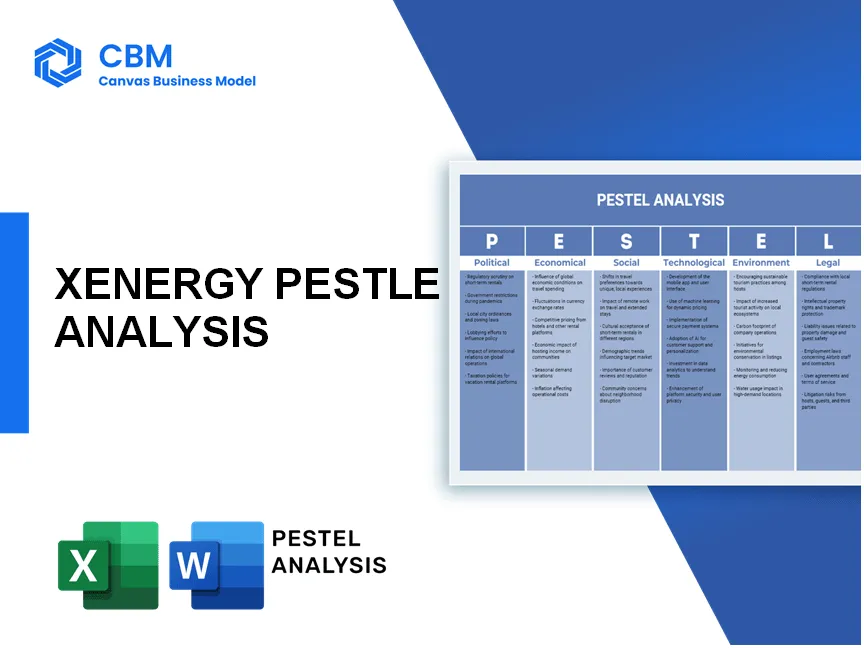In an era where the demand for sustainable energy has reached a fever pitch, X-energy stands at the forefront of revolutionizing nuclear power to meet our carbon-free ambitions. This blog post dives deep into the intricate landscape of X-energy through a PESTLE analysis, revealing the intertwined political, economic, sociological, technological, legal, and environmental factors that shape its operations and future prospects. Discover how these elements not only define the company's strategic direction but also influence the broader energy dialogue.
PESTLE Analysis: Political factors
Supportive government policies for clean energy initiatives
The U.S. government announced in April 2022 a commitment of $6 billion for nuclear power plants through the Civil Nuclear Credit Program, promoting the sustainability of existing reactors and encouraging new developments in nuclear technology.
Additionally, the Biden administration's goal is to achieve net-zero carbon emissions by 2050, which relies heavily on clean energy sources, including nuclear, as part of the overall energy strategy.
Regulatory frameworks favoring nuclear technology advancement
The Nuclear Regulatory Commission (NRC) has streamlined licensing processes for advanced nuclear reactors. In 2021, the NRC updated its regulations to facilitate the development of small modular reactors (SMRs), which X-energy specializes in.
In the United States, the Energy Policy Act of 2005 provided approximately $18.5 billion in loan guarantees for the construction of new nuclear power plants, positively impacting financing for nuclear projects.
International treaties promoting non-proliferation and safe nuclear energy
The Treaty on the Non-Proliferation of Nuclear Weapons (NPT), established in 1968 and currently signed by 191 countries, supports nuclear disarmament and promotes the peaceful use of nuclear energy. As of 2023, 70 countries have signed agreements for civil nuclear cooperation with the U.S., enhancing collaboration in nuclear technology.
The Paris Agreement, adopted in 2015, aims to limit global warming and has resulted in increased international collaboration for low-carbon technologies, including nuclear power.
Political stability influencing investment in nuclear power
Stable political environments typically yield higher investments in nuclear power. For instance, in 2020, the global nuclear power sector drew approximately $10 billion in investment, bolstered by political stability in countries like Canada and the UAE, which have robust frameworks to support nuclear energy developments.
According to the World Nuclear Association, as of 2023, there are 440 operable reactors worldwide, underscoring the alignment of political stability and investment trends in nuclear energy.
Lobbying efforts to secure favorable legislation
The Nuclear Energy Institute (NEI) spent about $8 million on lobbying efforts in 2021 to influence nuclear energy policies, ensuring support for regulatory frameworks that benefit nuclear technology.
In 2020, a coalition of 20 leading nuclear companies and organizations launched the “Nuclear for Climate” initiative, advocating for nuclear energy as a crucial component in reducing carbon emissions. This coalition operates in alignment with key legislative proposals aimed at supporting renewable energy.
| Year | U.S. Government Funding for Nuclear Initiatives ($B) | Global Investment in Nuclear Power ($B) | Nuclear Lobbying Expenditure ($M) |
|---|---|---|---|
| 2020 | 0.5 | 10 | 6 |
| 2021 | 6 | 10.3 | 8 |
| 2022 | 6 | 11 | 7 |
| 2023 | 6 | 12.2 | 8 |
[cbm_pestel_top]
PESTLE Analysis: Economic factors
Growing demand for low-carbon energy sources
The global shift towards sustainable energy has led to a significant increase in the demand for low-carbon energy sources. In 2022, the global renewable energy market was valued at approximately $1.5 trillion and is projected to reach $2.5 trillion by 2027, growing at a CAGR of 11.9%.
According to the International Energy Agency (IEA), nuclear power is expected to contribute significantly to the reduction of carbon emissions, helping to achieve targets set in international agreements such as the Paris Accord.
Investment opportunities in nuclear technology development
Investment in nuclear technology has seen a resurgence, with global nuclear energy investments reaching approximately $30 billion in 2021. The U.S. government has also pledged $6 billion in funding over the next few years to support the development of advanced nuclear reactors, including XENERGY's technology.
Moreover, in 2022, venture capital investments in advanced nuclear startups totaled $2.2 billion, indicating a strong investor interest in innovation within the sector.
Cost competitiveness of nuclear power compared to fossil fuels
The Levelized Cost of Electricity (LCOE) for nuclear power is estimated to be approximately $35 to $50 per megawatt-hour (MWh), making it competitive with natural gas, which ranges from $40 to $70 per MWh. In comparison, coal LCOE is approximately $60 to $143 per MWh, reflecting the increasing cost efficiency of nuclear power.
According to the U.S. Energy Information Administration (EIA), by 2030, nuclear energy could account for roughly 16% of the total U.S. electricity generation.
Economic incentives for renewable energy and nuclear power integration
Government policies and incentives play a crucial role in supporting nuclear energy integration. The Inflation Reduction Act of 2022 introduced tax credits of up to $15 per megawatt-hour for nuclear energy producers, encouraging investment and operational sustainability.
Additionally, numerous states have implemented Renewable Portfolio Standards (RPS) that include nuclear energy, further incentivizing its contribution to a low-carbon future.
Financial viability of nuclear projects amidst fluctuating energy markets
The financial landscape surrounding nuclear projects remains complex. In 2021, the U.S. Department of Energy estimated that the construction costs for new nuclear plants could range from $6,000 to $9,000 per kilowatt (kW) of installed capacity. Despite these costs, contracts for future projects show a growing interest due to increasing energy prices and demand stability.
Fluctuations in global energy prices can impact the financial viability of nuclear projects; however, projections suggest that over the next decade, the average natural gas price is expected to settle around $3 to $5 per million British thermal units (MMBtu), pushing the demand for stable nuclear energy as a reliable source.
| Metric | Value |
|---|---|
| Global Renewable Energy Market Value (2022) | $1.5 Trillion |
| Projected Market Value (2027) | $2.5 Trillion |
| U.S. Government Funding for Advanced Nuclear (Next Few Years) | $6 Billion |
| Venture Capital in Advanced Nuclear Startups (2022) | $2.2 Billion |
| Nuclear Power LCOE | $35 - $50 per MWh |
| Natural Gas LCOE | $40 - $70 per MWh |
| Coal LCOE | $60 - $143 per MWh |
| Nuclear Energy Contribution to U.S. Generation by 2030 | 16% |
| Inflation Reduction Act Tax Credit | $15 per MWh |
| Construction Cost for Nuclear Plants (2021 Estimate) | $6,000 - $9,000 per kW |
| Average Natural Gas Price (Next Decade) | $3 - $5 per MMBtu |
PESTLE Analysis: Social factors
Rising public awareness of climate change and need for sustainable energy
The global interest in climate change mitigation has been a driving factor for clean energy initiatives. According to a 2021 report by the International Energy Agency (IEA), over 70% of the world's population is now concerned about climate change. In the United States alone, 60% of respondents in a survey conducted by Pew Research found climate change to be a top priority for national policy.
Changing perceptions around the safety and benefits of nuclear power
Support for nuclear energy has seen a rise, especially as renewable energy sources have proven to be insufficient alone. As of 2023, public support in the U.S. for nuclear energy stands at approximately 52%, an increase from 45% in 2017, according to a Gallup poll. Additionally, a 2022 survey revealed that 70% of respondents believe nuclear power is essential for reducing carbon emissions.
Increased community engagement and stakeholder dialogue
Engagement with local communities plays a critical role in nuclear power project acceptance. According to a report by the World Nuclear Association, various nuclear projects in Europe have reported 65% higher approval ratings when community outreach programs are actively conducted. The number of public forums and stakeholder meetings conducted by companies like X-energy has reportedly increased by over 40% from 2018 to 2023.
Educational initiatives to improve understanding of nuclear technology
Investment in educational programs is key to bolstering public understanding of nuclear technology. X-energy, along with other organizations, has invested roughly $5 million in educational initiatives over the last three years. Programs aimed at high school students have reached over 200,000 individuals, focusing on the basics and benefits of nuclear technology.
Public acceptance crucial for planning and deployment of new reactors
The necessity for public acceptance in planning new nuclear projects cannot be overstated. A quantitative study revealed that projects that successfully garnered community support were 80% more likely to proceed without delays. In regions where public engagement was minimal, delays extended projects by an average of 5 years, resulting in potential cost overruns averaging $1 billion per project.
| Factor | Statistics | Source |
|---|---|---|
| Public Concern About Climate Change | 70% worldwide, 60% in the U.S. rank climate change as a top priority | International Energy Agency, Pew Research |
| Support for Nuclear Energy | 52% public support in the U.S. in 2023 | Gallup Poll |
| Community Engagement Impact | 65% increase in project approval ratings with active outreach | World Nuclear Association |
| Investment in Education | $5 million over three years, reaching over 200,000 students | X-energy initiatives |
| Public Acceptance and Project Delays | 80% more likely to proceed without delays when community support is secured | Quantitative study |
PESTLE Analysis: Technological factors
Innovations in reactor design for enhanced safety and efficiency
X-energy is developing the X-ELON reactor, which claims to increase fuel efficiency by up to 40% and provide inherent safety features such as passive cooling. The reactor operates at a temperature range of up to 750°C, enhancing the overall thermal efficiency which can exceed 40% compared to traditional reactors at less than 33%.
Development of advanced fuel materials and recycling processes
Utilizing fuel with a high thermal conductivity and stability, X-energy's TRISO (Tristructural-Isotropic) fuel particles can withstand temperatures over 1600°C. The company claims that the use of TRISO fuel can reduce long-lived radioactive waste by 25% and offers a recycling process that can potentially reclaim up to 95% of material.
Integration of digital technology for monitoring and operations
X-energy utilizes advanced digital twins and AI for real-time monitoring, providing operators with data for predictive maintenance. Their digital monitoring systems can reduce operational downtime by approximately 25%, translating into savings of about $1.5 million per year per reactor.
Research on small modular reactors (SMRs) offering flexibility
X-energy's research into SMRs positions them as leaders in modular nuclear technology. The SMR market is expected to reach $2.8 billion by 2025, driven by governments looking for flexible energy solutions. The estimated cost of their SMR deployment is around $6,000/kW, which is competitive compared to traditional large reactors.
Advances in automation and AI enhancing operational capability
According to industry reports, the integration of AI in nuclear operations can lead to operational savings of 15-20% annually. X-energy's automation processes have been shown to reduce human error rates by more than 50%, thereby enhancing safety and efficiency. Investment in AI technology stands at around $300 million in the next five years, aiming to develop smarter operational frameworks.
| Technological Factor | Description | Key Performance Metrics |
|---|---|---|
| Innovations in Reactor Design | X-ELON reactor for enhanced safety and efficiency. | Fuel efficiency increase of up to 40% |
| Advanced Fuel Materials | Utilization of TRISO fuel for temperature stability. | High thermal conductivity and reduced long-lived waste by 25% |
| Digital Technology Integration | Digital twins and AI for predictive maintenance. | Operational downtime reduction by 25% ($1.5 million savings per reactor yearly) |
| Research on SMRs | Development of modular nuclear solutions. | SMR market projected to reach $2.8 billion by 2025 |
| Advancements in Automation and AI | Enhanced operational capability through AI | 15-20% annual savings and 50% reduction in human error rates |
PESTLE Analysis: Legal factors
Compliance with international nuclear safety standards
The International Atomic Energy Agency (IAEA) sets safety standards that member states must follow. Compliance is critical for companies like X-energy. For example, IAEA’s Safety of Nuclear Reactors includes guidelines stipulated in documents such as Safety of Nuclear Reactors NSS-50 (2018). Part of compliance involves adhering to regulations pertaining to the construction, operation, and decommissioning phases that have significant financial implications. Investments for compliance can range upwards of $10 million per reactor, depending on the jurisdiction.
Navigating intellectual property rights in technology development
X-energy is significantly involved in advancing nuclear technology, leading to the necessity of protecting intellectual property (IP). In 2020, the global patent activity in nuclear technology related sectors amounted to approximately $3.5 billion. X-energy holds several patents related to its proprietary reactor designs, which can increase the company's valuation significantly. As of October 2023, the estimated value of the U.S. power generation technology market, which includes specialized nuclear technologies, is projected to be around $72 billion.
Licensing processes for new reactor designs and operations
The licensing process for new nuclear reactor designs in the U.S. is extensive, requiring approval from the Nuclear Regulatory Commission (NRC). The average timeline for obtaining a construction and operating license can take between 3 to 5 years and costs around $30 million. In 2023, the NRC reviewed applications amounting to approximately $3 billion for new reactor projects, indicating a robust activities schedule which X-energy may participate in.
Liability frameworks in cases of nuclear incidents
The Price-Anderson Nuclear Industries Indemnity Act provides a liability framework for nuclear incidents within the United States. It establishes a compensation pool of approximately $12.6 billion to cover damages caused by nuclear accidents. For licensing, X-energy is required to comply with these liability requirements, which can encompass insurance premiums expected to be in the range of $1-2 million annually. Furthermore, in 2021, nuclear power plants in the U.S. reported a total of $1.3 million in claims related to operational incidents.
Evolving regulations to support innovative nuclear solutions
Regulatory frameworks are increasingly adapting to support advanced nuclear technologies, with countries like Canada and the UK investing heavily in small modular reactors (SMRs). In 2022, the UK government allocated £450 million towards the development of advanced nuclear projects, while Canada announced a commitment of $20 billion towards SMR projects by 2030. This trend illustrates an evolving perspective which may benefit companies like X-energy in securing investment and favorable regulations.
| Legal Factor | Data/Statistical Metrics |
|---|---|
| Compliance Costs | $10 million (per reactor) |
| Patents in Nuclear Tech | $3.5 billion (global activity, 2020) |
| Licensing Cost | $30 million (average) |
| Price-Anderson Compensation Pool | $12.6 billion |
| Insurance Premiums | $1-2 million (annually) |
| UK Regulatory Investment | £450 million (2022) |
| Canada's Commitment to SMRs | $20 billion (by 2030) |
PESTLE Analysis: Environmental factors
Contributions to carbon-neutral energy goals
X-energy aims to contribute to carbon-neutral energy by developing advanced nuclear reactors that can produce up to 2,500 MW of power using low-enriched uranium. The company's energy system design is projected to reduce CO2 emissions by approximately 10 million metric tons per reactor per year compared to fossil fuel sources.
Management of nuclear waste and environmental impact assessments
Effective management of nuclear waste is critical to X-energy's operations. The company employs a strategy that involves:
- The use of high-assay low-enriched uranium (HALEU) which reduces the volume of waste generated by up to 30%.
- Implementation of stringent environmental impact assessments that adhere to U.S. Nuclear Regulatory Commission guidelines.
- Long-term waste management solutions with targeted facilities designed to store up to 50,000 metric tons of waste safely.
Minimizing ecological footprints through efficient reactor design
X-energy's reactor designs focus on minimizing ecological footprints. Key features include:
- Utilization of modular construction techniques that can lower construction waste by up to 20%.
- Operational efficiencies that allow reactors to run at over 95% capacity while complying with environmental regulations.
- Advanced cooling systems that reduce water use by approximately 30% compared to traditional reactors.
| Reactor Type | Estimated Capacity (MW) | Projected CO2 Emission Reduction (Metric Tons/year) | Waste Reduction (Volume) |
|---|---|---|---|
| Micro Modular Reactor | 10 | 10,000 | 30% |
| X-Energy High Temperature Gas Reactor | 320 | 2,500,000 | 30% |
| Advanced Small Modular Reactor | 300 | 2,000,000 | 30% |
Role of nuclear power in reducing reliance on fossil fuels
Nuclear power is pivotal for reducing dependence on fossil fuels. X-energy's commitment includes:
- Increasing the share of nuclear energy in the energy mix to at least 25% by 2030.
- Aiming for a zero-emission energy future by reclaiming the role of nuclear as a sustainable energy source.
- Reducing reliance on coal and natural gas plants through the deployment of its reactors that can operate 24/7.
Collaboration with environmental organizations for sustainable practices
X-energy actively collaborates with various environmental organizations, focusing on sustainable practices such as:
- Partnership with the World Nuclear Association for promoting nuclear power benefits.
- Engagement with Greenpeace to address nuclear waste issues and promote transparency.
- Participation in working groups with the International Atomic Energy Agency to enhance safety and sustainability measures across the industry.
In conclusion, X-energy stands at the forefront of the nuclear energy revolution, propelled by a unique blend of political support, economic opportunity, and technological innovation. The company’s commitment to sustainability and the development of cutting-edge reactor designs not only addresses the pressing need for carbon-free energy but also involves the communities it serves through ongoing dialogue and education. As legal frameworks evolve to embrace this transformative energy source, and environmental challenges persist, X-energy's holistic approach underscores the critical role of nuclear power in achieving a sustainable future.
[cbm_pestel_bottom]












